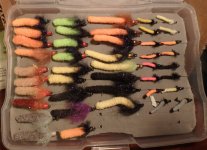Fly-Swatter
Well-known member
- Joined
- Mar 23, 2014
- Messages
- 1,243
Warning: Winter musings ahead!
So, I'm sitting here drinking my morning coffee, watching fly tying videos and wondering what exactly is the problem many fly fishers have with Mop Flies. Is it an image problem. I mean, they ARE called "MOP" flies Does that imply they are dirty?
We have no problem with chenille WRAPPED AROUND a hook (ie, woolly bugger), but we seem to turn our collective noses up at chenille DANGLING FROM a hook (ie, san juan worm, mop fly). Does the green weenie straddle this line?
I realize, on a philosophical level, we all find our happiness individually, but why draw the line here. It seems arbitrary to me.
I don't mean for this to sound sarcastic. I really would like to hear many opinions on this.
So, I'm sitting here drinking my morning coffee, watching fly tying videos and wondering what exactly is the problem many fly fishers have with Mop Flies. Is it an image problem. I mean, they ARE called "MOP" flies Does that imply they are dirty?
We have no problem with chenille WRAPPED AROUND a hook (ie, woolly bugger), but we seem to turn our collective noses up at chenille DANGLING FROM a hook (ie, san juan worm, mop fly). Does the green weenie straddle this line?
I realize, on a philosophical level, we all find our happiness individually, but why draw the line here. It seems arbitrary to me.
I don't mean for this to sound sarcastic. I really would like to hear many opinions on this.






